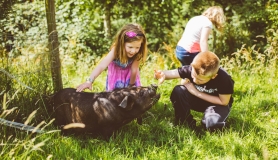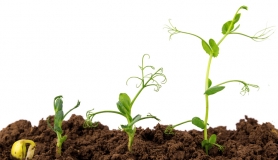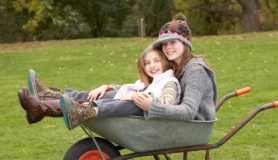There are so many compelling reasons for growing even a little of your own food in the garden or allotment, on the patio, or even on the windowsill. Take for instance the humble lettuce. On average over 11 pesticides are sprayed on lettuces, more than any other vegetable crop. In one study by what used to be the Ministry of Agriculture, Fisheries and Food (MAFF), pesticide applications had increased by 600% over a ten year period. Then those innocent bags of mixed salad from the supermarket are washed with chloride to prevent decay. This is hardly healthy eating for our children. Food can contribute up to one third of your family’s carbon footprint – so buying locally produced food and growing your own is one of the greenest things you can do. It is also great fun and children love gardening.
Learning From Nature
As the old saying goes, ‘Nature is the best teacher’ and permaculture is based on observing natural systems, deriving principles to understand how they work and then applying this to design low carbon, green systems. These can be anything from a farm, woodland or community, but one of the best ways to demonstrate permaculture is in the garden. Here we can make connections, turn our waste into useful resources and create selfsustaining cyclical systems that work together healthily. A typical example of a way of imitating nature in the permaculture garden is by mulching the soil. In a woodland, nature rarely leaves the soil bare. Leaves form a moist covering to the soil and rot down, making a fertile dark loam full of beneficial micro-organisms to feed saplings, established trees and shrubs and other flora and prevent nutrients being eroded away by wind and rain. In the garden we too can make leaf mould, compost and use cardboard, woodchip and straw to cover and feed the soil, establish rich loamy beds full of worms to turn the soil and make it fertile. Mulch also suppresses weeds. Adding compost also creates healthy soil as well as being an important way of reducing household waste. Currently, the average household throws away 14.1kg of compostable waste – the equivalent in weight of 24 bags of sugar per week.
Setting up a Garden in Spring
The first task is to establish good composting systems as soon as possible. If you have room you can make your own composters from recycled pallets and add a mixture of kitchen waste (uncooked), grass cuttings and materials like shredded paper and spoilt straw to get the right mixture of nitrogen and carbon. You can also make a composter specifically for leaves and also one for ‘green brew’ – a DIY liquid organic fertiliser (see below). If you have limited space proprietary composters (often available at a reduced price from your local council) and a worm bin for cooked food and vegetable scraps are very useful. If you are starting from scratch select an area near your house for your veggie beds and composting area. The aphorism that the best fertiliser is the gardener’s shadow is so true. We all tend to live busy lives and so growing food near the kitchen door makes it easier to pop out, pull a few weeds, sow some seeds and compost our waste. Make sure your beds are wide enough to reach in the middle but not too wide so that you have to stand on them to work, which compacts the soil and causes water logging. Define the edges of beds with long planks if you can but not bricks or stones in a damp climate, as these are ideal habitats for slugs and snails. Planks clearly mark the paths and are also useful for the children to know exactly where to tread. They allow you to build up the soil and make raised beds, which will not need to be dug once you have removed all the weeds. There are many advantages to mulching and spot weeding rather than digging. Soil is a living being with a delicate balance of micro-organisms that interact and digging damages this living microcosm and destroys soil structure. Its much better to leave the ploughing to the worms, who turn the soil and aerate it. Don’t forget to add lots of wellrotted organic matter. Next, select what to grow and order in your seeds. This is the fun part so be sure to involve the kids and choose vegetables and salads that they actually like to eat. There is no point growing food they don’t like! A strawberry bed is usually a must but remember you can also plant alpine strawberries anywhere in the garden as ground cover and children will enjoy foraging for their small but delicious fruits.
My children love vegetables like sweetcorn, French beans, parsnips, spinach, carrots, various varieties of beefsteak, bush and cherry tomatoes, broad beans and spaghetti and butternut squashes. These are always top of my list for space. I also like to plant as many varieties of ‘cut and come again’ and self seeding salads as possible such as mizuna, mibuna, oak leaf lettuces, land cress, rocket, and corn salad. Most seed catalogues have salad mixes that you can sow in one go so that you get variety for the price of just one packet – even a small salad bed can save a fortune on the weekly shopping bill and provide healthy greens from early spring to late autumn. There is nothing as scrumptious as freshly picked greens and children love helping with the harvesting. Of course, we prefer to buy organic seeds and also mainly choose varieties that are ‘heritage’ or at least not hybrids. F1 hybrid seeds may look nice but they are bred for a mass market and are not self-fertile and you can’t save their seed and germinate them next year. Heritage seeds are usually the older varieties that may not be popular in the supermarket (because they lack uniformity of size, shape or colour or don’t store well in refrigerated units) but they are often more tasty, store well and produce good seeds for next year. They can be more robust against pests and diseases as well and by growing them you are supporting biodiversity in the garden. My favourite spring job, besides getting out on crisp days and preparing the beds for sowing, is planting seeds inside. Children enjoy sowing pots and seed trays and watching them germinate in the warm. This is biology at home. My daughters never had any problem understanding hydro-, photoor geo-tropism at school. They had learnt that plant growth is determined by moisture, light and gravity on the windowsill from an early age. Botany too is so much easier to learn when you have a familiarity with germination, photosynthesis and how roots grow, for instance. All in all, growing plants is a wonderful way for a family to play and learn together and enjoy being outside. “Growing what you eat has to be a good thing,” says my daughter Gail. “You understand where food comes from and want to try new vegetables because you have grown them yourself. Who wouldn’t want to garden with their mum and dad? It’s such fun. You play outside and get your hands dirty!”
How to Make Your Own Organic Fertiliser
Take a barrel with a tap that’s not connected to a downpipe. Add rainwater. Then add comfrey, stinging nettles (before they have gone to seed) and a shovelful of manure. Leave to ‘brew’ for a few weeks. Be prepared for the smell and avoid contact with your hands! Dilute 1:10 in water and use as a fertiliser on maturing plants but not seedlings and watch them grow.
Maddy Harland is the editor of Permaculture Magazine – Solutions for Sustainable Living. She lives in Hampshire with her husband, Tim, and two daughters.







